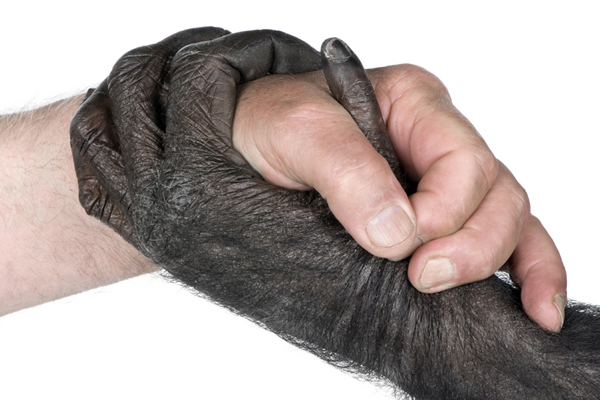Ape or Human? Fossils' Link to Evolution Questioned

In a paper published Feb. 19 in the science journal Nature, two paleoanthropologists argue that some recently discovered primate fossils may not be as human as everyone thinks. While the authors maintain that humans did, of course, evolve from apes, their contentions highlight the difficulty of using 7-million-year-old bone fragments to piece together the full story of human evolution.
The fossils in question — corresponding to species named Orrorin tugenensis,Sahelanthropus tchadensis and Ardipithecus ramidus — have all made headlines in recent years for filling in gaps in the evolution from apes to humans. Though they've been hailed as remnants of some of our earliest hominin ancestors, paleoanthropologists Bernard Wood of George Washington University and Terry Harrison of New York University say they're probably just non-hominin ape bones.
"The problem is that a number of features that have been identified as being related to humans may be interpreted in different ways," Harrison told Life's Little Mysteries, a sister site to LiveScience.
For example, all that has been found of Sahelanthropus, the oldest genus widely believed to have been a hominin, is a 7-million-year-old partial skull. And yet, from its shape, paleoanthropologists have concluded that the specimen must have walked upright. "The position of its foramen magnum"—the spot where the brain connects to the spinal cord—"has historically been argued to be associated with bipedalism," said Harrison. "However, we see from comparative anatomy that that's not always the case."
In 2008, Orrorin, the second-oldest alleged hominin, was also argued to be bipedal in an article in Science by William Jungers at Stony Brook University and his colleagues. But Harrison and Wood argue that Orrorin might not have walked upright either.
And of the famous 4.4-million-year-old Ardipithecus partial skeleton found in 2009, Harrison said, "It's a remarkable find. It's really incredible to have such an old skeleton of a potential human ancestor. But we would argue it seems to look like many of the forms of the apes we have seen from that period."
Skepticism regarding these famous primate fossil finds seems to call into question the rigor of the scientific process within the field of paleoanthropology. Wood's and Harrison's paper certainly makes one wonder: Are these isolated incidents of misinterpretation followed by media hype, or does the problem pervade the whole branch of science? Is the human evolutionary fossil record a crapshoot?
Get the world’s most fascinating discoveries delivered straight to your inbox.
"No," said Harrison. There are reasons why this branch of science may seem messier than most, he said, but all things considered, it is doing extremely well.
One in a million
"In science, there are always differences in interpretation and debate. It takes a long time for an answer to emerge. But it takes even longer with historical sciences – ones that don't allow experiments," Harrison said.
"These were species that lived millions of years ago in one small region in Africa." What's more, Harrison explained, the species in question had small populations. "So there are only isolated examples around today, and it's hard for people to respond to a paper when it comes out because they don't have the original material. Slowly, more scientists get a chance to look at the specimens, and the debate continues and eventually gets resolved."
Finding the correct ages of fossils is also problematic. "There are spectacular techniques to date excavation sites, but there are limits to what you can use them on," Harrison said. "Argon-argon dating is really precise, for example, but it requires the presence of volcanic rocks and you can't find those everywhere. Cave sites are particularly hard to date. Carbon-14 dating kicks in for anything up until 40,000 years ago but before that is unreliable."
An added difficulty, as Harrison and Wood point out in their paper, is the occurrence of homoplasy – a situation where the traits of two species have evolved to look similar, as opposed to looking similar because of a close genetic relationship.
Jungers, the paleoanthropologist who wrote about Orrorin's bipedalism, agrees with the Nature authors on that particular point. "Homoplasy is a real problem in the study of the fossil record, whether we're talking about humans or other groups," Jungers told Life's Little Mysteries. "It's a complicating factor that a similarity doesn't necessarily imply shared ancestry or a particularly close relationship. That take-home message is good for everybody in the field to keep in the back of their mind."
Considering all those difficulties, Harrison and Jungers both described our understanding of human origins as surprisingly well-developed. "Because we spend the most time and money excavating sites we know will be best for finding hominin fossils, the human fossil record is one of the best known of any," said Harrison.
According to Jungers, the issues raised in the new Nature paper ought not to be over-generalized. "The human fossil record is one of the best in biology. That's one of the reasons people can nitpick over its finer points."By the time modern humans evolved 200,000 years ago, the fossil evidence they left behind is extensive, and from 50,000 to 60,000 years ago on, our ancestors left fossils over a large region of the world. But the record is quite solid going back much farther into the past.
"The indisputable human ancestral record starts around 4.2 million years ago. Only the details are left to be worked out," Harrison said.
"That's pretty good going."
Follow Natalie Wolchover on Twitter @nattyover.
This article was provided by Life's Little Mysteries, a sister site to LiveScience.
Natalie Wolchover was a staff writer for Live Science from 2010 to 2012 and is currently a senior physics writer and editor for Quanta Magazine. She holds a bachelor's degree in physics from Tufts University and has studied physics at the University of California, Berkeley. Along with the staff of Quanta, Wolchover won the 2022 Pulitzer Prize for explanatory writing for her work on the building of the James Webb Space Telescope. Her work has also appeared in the The Best American Science and Nature Writing and The Best Writing on Mathematics, Nature, The New Yorker and Popular Science. She was the 2016 winner of the Evert Clark/Seth Payne Award, an annual prize for young science journalists, as well as the winner of the 2017 Science Communication Award for the American Institute of Physics.

